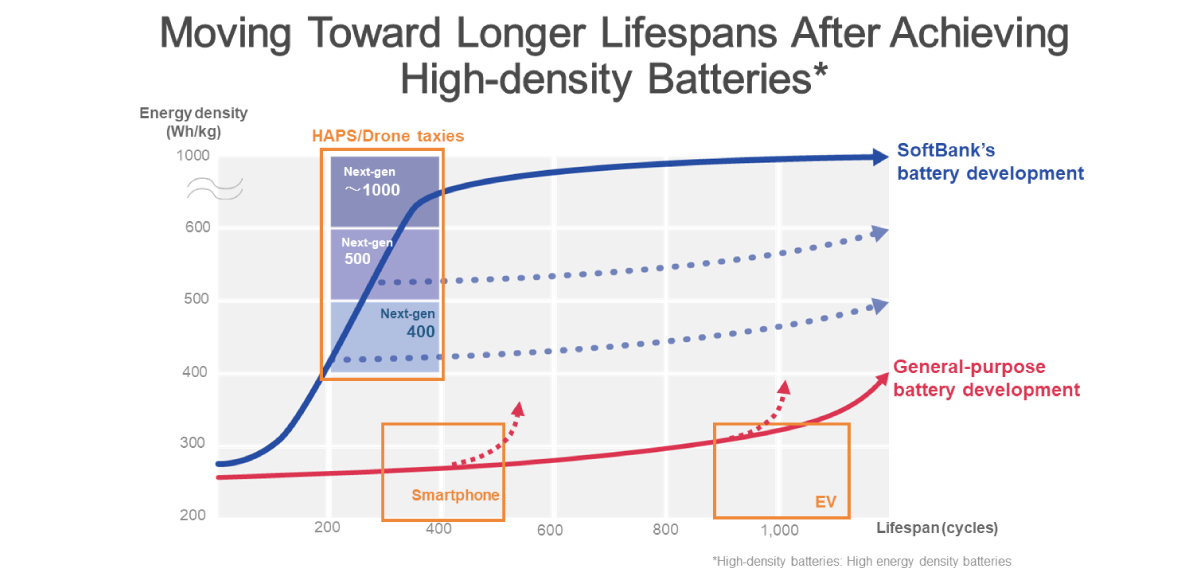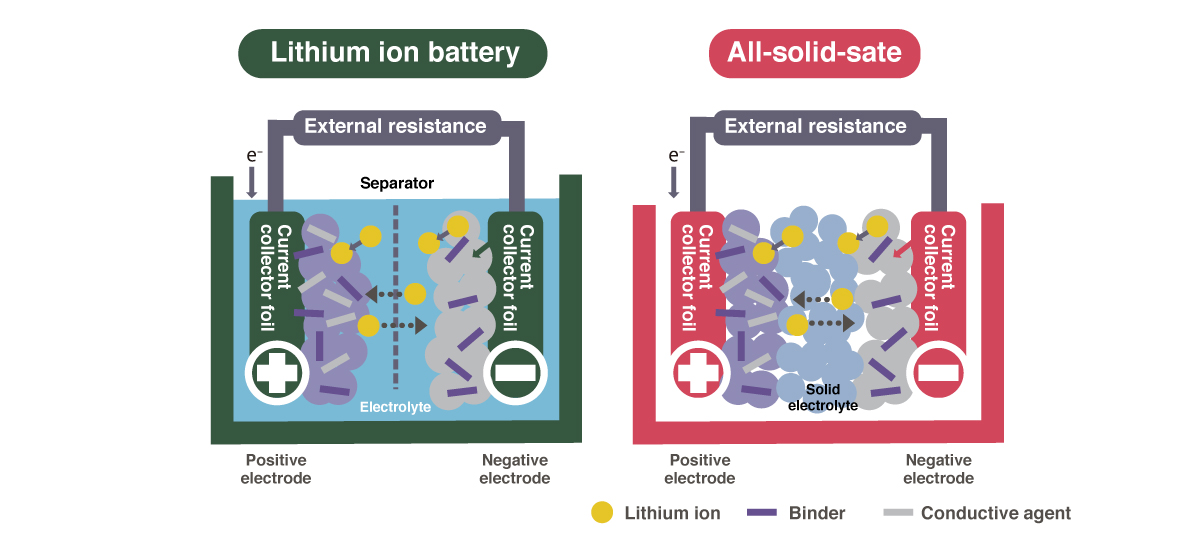Blogs
- Feb 22, 2023
- Blog
- HAPS
SoftBank’s Next-Generation Battery Development
#Next-Generation Battery
Scroll
SoftBank’s Next-Generation Battery Development
At the SoftBank Research Institute of Advanced Technology, we have been carrying out research and development (R&D) activities for the practical application of battery cells with a high specific energy density.
- *specific energy density (Wh/kg): the amount of energy per weight contained in a battery. The greater this value becomes, the more energy can be stored in a battery while keeping the weight the same.
The Research Institute of Advanced Technology started a joint research project regarding air batteries with the National Institute for Materials Science (NIMS) in 2018. Since then, we have been carrying out joint development projects with various of research institutes and corporations. These joint projects include research on organic cathode secondary batteries with the National Institute of Advanced Industrial Science and Technology (hereafter referred to as AIST) and research on lithium metal batteries with Mie University and Enpower Japan Co., Ltd.
Actually, we didn't start with the intention to develop a battery.
Initially, we conducted a market survey to procure lightweight next-generation batteries suitable for the HAPS (High Altitude Platform Station) system that provides communication networks from the "stratosphere." However, we found out that there were no batteries in the market that could maintain an energy density of 400Wh/kg after 200 cycles - a requirement demanded by SoftBank. As a result, we decided to develop the next-generation battery that meets the required specifications ourselves.
- *Cycle: One charge cycle is the cycle in which a battery’s power is charged from 0% to 100%, and then returns to 0% again.

While battery development is typically aimed at prolonging battery life for use in smartphones and electric vehicles, our development prioritizes "weight" (specific energy density) rather than the "length of their lifespan” (cycle life). This is because for HAPS, for which the battery cells can be changed once in the relatively short period of 6 months, it is sufficient if the battery cells can last for at least six months. For HAPS battery cells, specific energy density is more important than cycle life.
We plan to shift our focus to prolonging lifespans once we have achieved the development of batteries with high specific energy density.
"We do not intend to compete with battery manufacturers. Instead, our research is focused on improving battery performance to enable new services, including HAPS. Therefore, we actively support research institutes and companies that promote the development of high-performance batteries and materials. We also collaborate with external partners to conduct joint research to improve battery performance.

What Types of Batteries are We Working on?
SoftBank is currently focusing on battery cells that have the potential to maintain high gravimetric energy densities, for which there are very few development or research precedents. From among these, we have selected several types of batteries, and created development strategies for these.

Development of lithium metal batteries
We have completed our development at the material and cell level for the first generation of our development strategies: lithium metal batteries. We are currently assessing the mass-production of cells and the manufacturing of battery packs for these batteries.
Through our research so far, we have found that a higher confined pressure increases the lifespan of lithium metal batteries. However, there is no configuration among current battery packs for increasing the confined pressure, and such a configuration needs to be newly developed.
One of the challenges in developing the new pack is eliminating the heavy components such as metal plates and reducing the weight. In addition, high thermal insulation and pressure resistant mechanisms are also required to cope with the stratospheric environment for HAPS use.


Our development at the material and cell levels has currently moved on to the 2nd generation: batteries having a specific energy density of 600Wh/kg or higher. We are currently developing the next-generation batteries after lithium metal batteries, including “all-solid-state batteries”, “organic cathode secondary batteries”, and “metal air batteries”.
Development of all-solid-state batteries
All-solid-state batteries have a lower specific energy density due to the higher specific gravity of solid electrolytes. However, they offer advantages such as improved safety and the ability to operate in a wider range of voltages and temperatures.
Improved safety of the battery cells allows for simplification of safety mechanisms in the battery packs, as well as the potential for reducing the weight of parts by eliminating the need for thermal insulation materials and cooling mechanisms due to a wider usable temperature range.
Case examples for the operation of high-volume materials, which up until now could not be used for liquid-electrolyte batteries, have been reported by other organizations. Based on these examples, SoftBank is also focusing its development efforts on these materials.

Development of organic cathode secondary batteries
Organic cathode secondary batteries are attracting attention for their low-cost and light-weight materials in comparison to current batteries, which use rare metals.
On the other hand, they pose problems pertaining to their cycle performance, volumetric energy density, and rate property. As a result, only few companies are engaged in the development of this type of batteries.
Cycle Performance Issues
Organic cathode active materials easily dissolve in organic solvents (electrolytes). Due to this property, the cathode seeps through, and as result, the battery power deteriorates more quickly. To resolve this problem, we have developed a technology to limit dissolution through a joint research project with AIST. In addition, we believe that these problems can be solved by promoting a shift to all-solid-state battery cells in the future.
Volumetric Energy Density Issues
Organic molecules with a low volumetric energy density were thought to be unsuitable for fields that focus on reductions in the size of batteries, including smartphones and electric vehicles. However, using a new material that we developed together with AIST, we have come to understand that these exhibit the same volumetric energy density as current batteries.
Rate Characteristics Issues
The high resistance of organic cathode active materials presented the problem that it is impossible to yield a large current therefrom (low rate characteristics). However, our research found that resistance can be reduced by using the oligomerization technology developed by AIST, as well as changing the structure of the electrodes. This helped us to gain a prospective improvement in rate characteristics.
- *Oligomerization technology: a polymer compound with a relatively low molecular weight, which is generated as a result of the polymerization of two to twenty molecules of the same kind. The diagram shows the oligomerization of Phenazinetetrone (PTO), an organic cathode active material.
By solving the three issues described above, we have confirmed the feasibility of organic cathode secondary batteries, and have therefore embarked on their full-scale development.
In addition, SoftBank proposed a research project titled “the analysis of charging and /discharging mechanisms of organic cathode secondary batteries and research on how to increase their energy density,” and was selected for the new research theme for the fiscal year 2022 by the Acquisition, Technology & Logistics Agency as part of its program to promote security technologies. Through our work on this research project, we aim to develop a long-lasting organic cathode secondary battery with a specific energy density exceeding 500 Wh/kg.

The development of next-generation batteries is essential to create new businesses that utilize advanced technologies, as well as the evolution of the existing industries. We will continue our research and development activities towards various next-generation batteries, utilizing materials informatics and computing science.
- 28.02.2023
- Quantum Technology
SoftBank Corp. and SandboxAQ Jointly Verify Hybrid Mode Quantum-safe Technology

